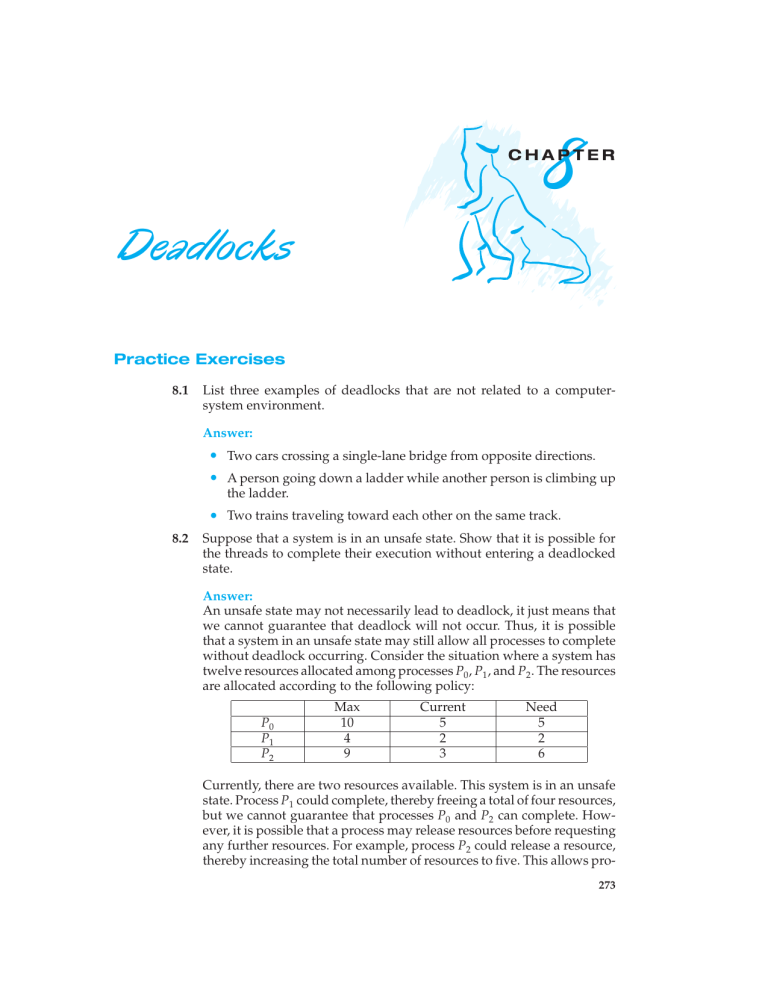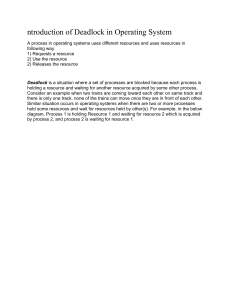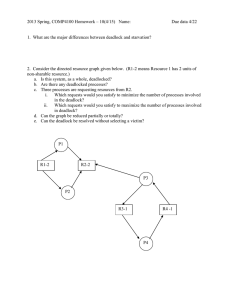
8
CHAPTER
Deadlocks
Practice Exercises
8.1
List three examples of deadlocks that are not related to a computersystem environment.
Answer:
• Two cars crossing a single-lane bridge from opposite directions.
• A person going down a ladder while another person is climbing up
the ladder.
• Two trains traveling toward each other on the same track.
8.2
Suppose that a system is in an unsafe state. Show that it is possible for
the threads to complete their execution without entering a deadlocked
state.
Answer:
An unsafe state may not necessarily lead to deadlock, it just means that
we cannot guarantee that deadlock will not occur. Thus, it is possible
that a system in an unsafe state may still allow all processes to complete
without deadlock occurring. Consider the situation where a system has
twelve resources allocated among processes P0 , P1 , and P2 . The resources
are allocated according to the following policy:
P0
P1
P2
Max
10
4
9
Current
5
2
3
Need
5
2
6
Currently, there are two resources available. This system is in an unsafe
state. Process P1 could complete, thereby freeing a total of four resources,
but we cannot guarantee that processes P0 and P2 can complete. However, it is possible that a process may release resources before requesting
any further resources. For example, process P2 could release a resource,
thereby increasing the total number of resources to five. This allows pro273
274
Chapter 8 Deadlocks
cess P0 to complete, which would free a total of nine resources, thereby
allowing process P2 to complete as well.
8.3
Consider the following snapshot of a system:
T0
T1
T2
T3
T4
Allocation
ABCD
0012
1000
1354
0632
0014
Max
ABCD
0012
1750
2356
0652
0656
Available
ABCD
1520
Answer the following questions using the banker’s algorithm:
a.
What is the content of the matrix Need?
b.
Is the system in a safe state?
c.
If a request from thread T1 arrives for (0,4,2,0), can the request be
granted immediately?
Answer:
a. The values of Need for processes P0 through P4 , respectively, are (0,
0, 0, 0), (0, 7, 5, 0), (1, 0, 0, 2), (0, 0, 2, 0), and (0, 6, 4, 2).
8.4
b.
The system is in a safe state. With Available equal to (1, 5, 2, 0),
either process P0 or P3 could run. Once process P3 runs, it releases
its resources, which allows all other existing processes to run.
c.
The request can be granted immediately. The value of Available is
then (1, 1, 0, 0). One ordering of processes that can finish is P0 , P2 ,
P3 , P1 , and P4 .
A possible method for preventing deadlocks is to have a single,
higher-order resource that must be requested before any other resource.
For example, if multiple threads attempt to access the synchronization
objects A · · · E, deadlock is possible. (Such synchronization objects may
include mutexes, semaphores, condition variables, and the like.) We can
prevent deadlock by adding a sixth object F. Whenever a thread wants
to acquire the synchronization lock for any object A · · · E, it must first
acquire the lock for object F. This solution is known as containment:
the locks for objects A · · · E are contained within the lock for object F.
Compare this scheme with the circular-wait scheme of Section 8.5.4.
Answer:
This is probably not a good solution because it yields too large a scope. It
is better to define a locking policy with as narrow a scope as possible. The
circular wait approach is a reasonable approach to avoiding deadlock,
and does not increase the scope of holding a lock.
8.5
Prove that the safety algorithm presented in Section 8.6.3 requires an
order of m × n2 operations.
Practice Exercises
275
Answer:
The figure below provides Java code that implements the safety algorithm of the banker’s algorithm (the complete implementation of the
banker’s algorithm is available with the source-code download for this
text).
for (int i = 0; i < n; i++) {
// first find a thread that can finish
for (int j = 0; j < n; j++) {
if (!finish[j]) {
boolean temp = true;
for (int k = 0; k < m; k++) {
if (need[j][k] > work[k])
temp = false;
}
if (temp) { // if this thread can finish
finish[j] = true;
for (int x = 0; x < m; x++)
work[x] += work[j][x];
}
}
}
}
As can be seen, the nested outer loops—both of which loop through
n times—provide the n2 performance. Within these outer loops are two
sequential inner loops that loop m times. The Big O of this algorithm is
therefore O(m × n2 ).
8.6
Consider a computer system that runs 5,000 jobs per month and has no
deadlock-prevention or deadlock-avoidance scheme. Deadlocks occur
about twice per month, and the operator must terminate and rerun
about ten jobs per deadlock. Each job is worth about two dollars (in CPU
time), and the jobs terminated tend to be about half done when they are
aborted.
A systems programmer has estimated that a deadlock-avoidance
algorithm (like the banker’s algorithm) could be installed in the system
with an increase of about 10 percent in the average execution time per
job. Since the machine currently has 30 percent idle time, all 5,000 jobs
per month could still be run, although turnaround time would increase
by about 20 percent on average.
a.
What are the arguments for installing the deadlock-avoidance
algorithm?
b.
What are the arguments against installing the deadlock-avoidance
algorithm?
Answer:
276
Chapter 8 Deadlocks
An argument for installing deadlock avoidance in the system is that we
could ensure that deadlock would never occur. In addition, despite the
increase in turnaround time, all 5,000 jobs could still run.
An argument against installing deadlock-avoidance software is that
deadlocks occur infrequently, and they cost little when they do occur.
8.7
Can a system detect that some of its threads are starving? If you answer
“yes,” explain how it can. If you answer “no,” explain how the system
can deal with the starvation problem.
Answer:
Starvation is a difficult topic to define, as it may mean different things for
different systems. For the purposes of this question, we will define starvation as the situation in which a process must wait beyond a reasonable
period of time —perhaps indefinitely—before receiving a requested
resource. One way of detecting starvation would be to first identify a
period of time —T —that is considered unreasonable. When a process
requests a resource, a timer is started. If the elapsed time exceeds T, then
the process is considered to be starved.
One strategy for dealing with starvation would be to adopt a policy whereby resources are assigned only to the process that has been
waiting the longest. For example, if process Pa has been waiting longer
for resource X than process Pb , the request from process Pb would be
deferred until process Pa ’s request has been satisfied.
Another strategy would be less strict. In this scenario, a resource
might be granted to a process that had waited less than another process,
providing that the other process was not starving. However, if another
process was considered to be starving, its request would be satisfied first.
8.8
Consider the following resource-allocation policy. Requests for and
releases of resources are allowed at any time. If a request for resources
cannot be satisfied because the resources are not available, then we check
any threads that are blocked waiting for resources. If a blocked thread
has the desired resources, then these resources are taken away from it
and are given to the requesting thread. The vector of resources for which
the blocked thread is waiting is increased to include the resources that
were taken away.
For example, a system has three resource types, and the vector Available is initialized to (4,2,2). If thread T0 asks for (2,2,1), it gets them. If
T1 asks for (1,0,1), it gets them. Then, if T0 asks for (0,0,1), it is blocked
(resource not available). If T2 now asks for (2,0,0), it gets the available
one (1,0,0), as well as one that was allocated to T0 (since T0 is blocked).
T0 ’s Allocation vector goes down to (1,2,1), and its Need vector goes up
to (1,0,1).
a.
Can deadlock occur? If you answer “yes,” give an example. If you
answer “no,” specify which necessary condition cannot occur.
b.
Can indefinite blocking occur? Explain your answer.
Answer:
Practice Exercises
8.9
277
a.
Deadlock cannot occur, because preemption exists.
b.
Yes. A process may never acquire all the resources it needs if they
are continuously preempted by a series of requests such as those
of process C.
Consider the following snapshot of a system:
T0
T1
T2
T3
T4
Allocation
ABCD
3014
2210
3121
0510
4212
Max
ABCD
5117
3211
3321
4612
6325
Using the banker’s algorithm, determine whether or not each of the
following states is unsafe. If the state is safe, illustrate the order in which
the threads may complete. Otherwise, illustrate why the state is unsafe.
a.
Available = (0, 3, 0, 1)
b.
Available = (1, 0, 0, 2)
Answer:
a.
8.10
Not safe. Processes P2 , P1 , and P3 are able to finish, but no remaining processes can finish.
Safe. Processes P1 , P2 , and P3 are able to finish. Following this,
processes P0 and P4 are also able to finish.
Suppose that you have coded the deadlock-avoidance safety algorithm
that determines if a system is in a safe state or not, and now have been
asked to implement the deadlock-detection algorithm. Can you do so by
simply using the safety algorithm code and redefining Maxi = Waitingi
+ Allocationi , where Waitingi is a vector specifying the resources for
which thread i is waiting and Allocationi is as defined in Section 8.6?
Explain your answer.
Answer:
Yes. The Max vector represents the maximum request a process may
make. When calculating the safety algorithm, we use the Need matrix,
which represents Max — Allocation. Another way to think of this is Max
= Need + Allocation. According to the question, the Waiting matrix fulfills
a role similar to the Need matrix; therefore, Max = Waiting + Allocation.
8.11
Is it possible to have a deadlock involving only one single-threaded
process? Explain your answer.
Answer:
No. This follows directly from the hold-and-wait condition.




